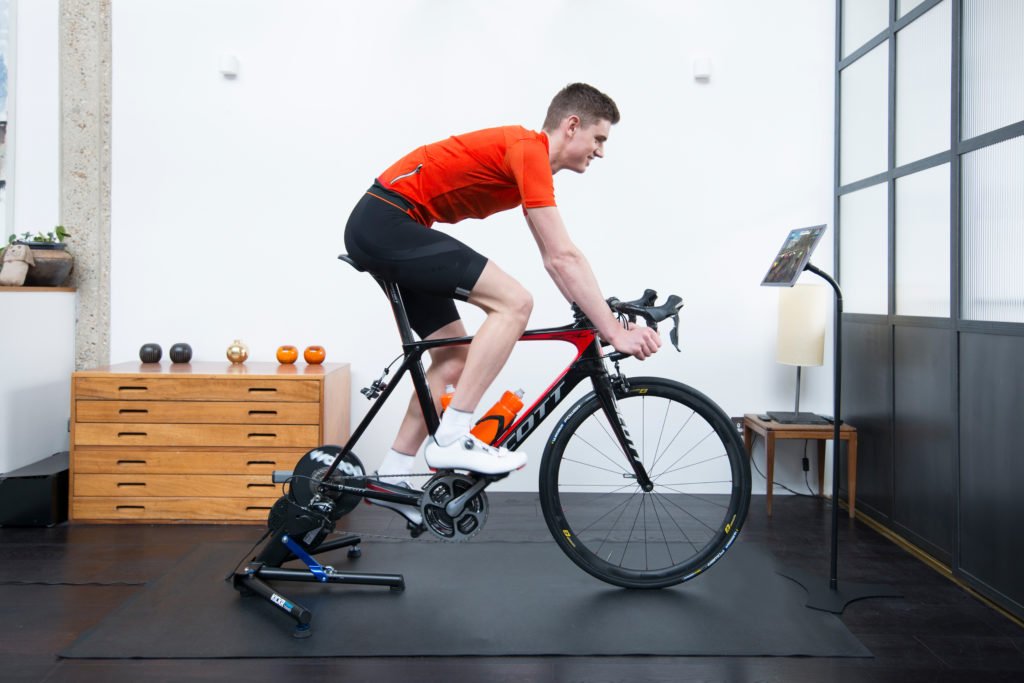While nothing beats the experience of cycling outside, winter weather certainly makes it less pleasant. It’s some combination of cold, dark and wet, and at the end of the day we’re only human.
So if you don’t fancy the idea of indoor cycling, then Zwift could be just what you need. Forget pseudo-disco spin classes and mind-numbing turbo sessions staring out of the window, Zwift is a whole different ball game.

What Is Zwift?
Zwift is an immersive game and fitness tool rolled into one. The aim is to make indoor cycling social, interactive, challenging, and above all, fun.
By pairing your turbo trainer with a laptop or tablet, the immersive game allows you to create an avatar who travels through a virtual world as you pedal in the real one. You can cycle on virtual courses, ride casually with other users, and even enter virtual races.
The detailed 3D landscapes which your avatar can explore are designed to alleviate the boredom of turbo sessions and provide a realistic cycling experience from the comfort, warmth and dryness of your living room.
What Do I Need To Get Started?
Getting started is simple. This flow chart shows how little you actually need:
- Bike
- Computer or tablet
- Zwift software. There is a 7 day trial, after which it’s £12.99 per month
- ANT+ USB dongle
- Turbo trainer
- Cadence sensor / power meter
What trainers can I use with Zwift?
It’s important to consider how much you will be using Zwift, as turbo trainers (like everything in cycling) can be very expensive. But if you can afford it, higher spec trainers create a more realistic cycling experience and can be a valuable addition to your training schedule all year round. The options compatible with Zwift are listed on their website and we also recommend turbobiketrainer.com as a great source of further information.
Smart Trainer:
Smart trainers link to Zwift and automatically change the resistance when needed, such as on a virtual hill. These provide the most realistic and immersive conditions to make your ride more engaging, but as a result come with a higher price tag.
Classic Trainer:
For these, you’ll likely need a cadence sensor or power meter to connect your efforts to Zwift. Some are specifically enabled to work with ‘zPower’, Zwift’s own virtual power curve which is more responsive than typical linear virtual power curves. While power meters are a fantastic bit of kit, they are again expensive. For more information, cyclepowermeters.com have a look at our post Getting Started With Zwift Part 2 – Fitting Speed and Cadence Sensors.
As well as turbos, you can also use Zwift with indoor stationary bikes or on rollers or smart rollers. Because of the lack of stability of rollers, they’re a good way to recreate your outdoor cycling experience and force you to balance yourself. It’s worth setting up in a doorway or a near a wall to prevent any falls at first!
I’ve got the gear, now what?
Make sure your training zone is set up appropriately – you’ll need a drink, a towel, a sweat mat and good ventilation.
Making the most of Zwift comes through trying it out; explore the different worlds, try out the different training features and find upcoming group rides on Zwift’s event page. The Zwift Facebook group is also a great place to chat about courses, find some riding buddies and ask questions (technophobes, we’re looking at you), while the Zwift website has a helpful FAQ section submitted by users.